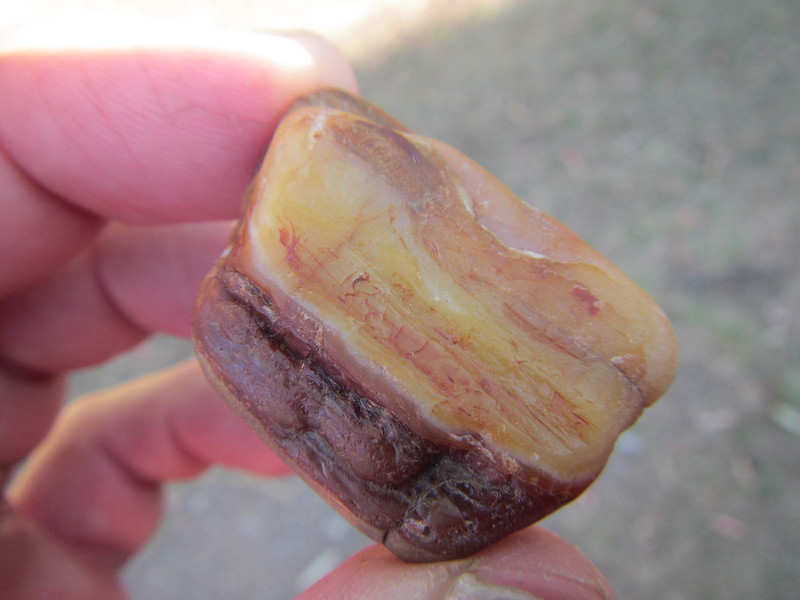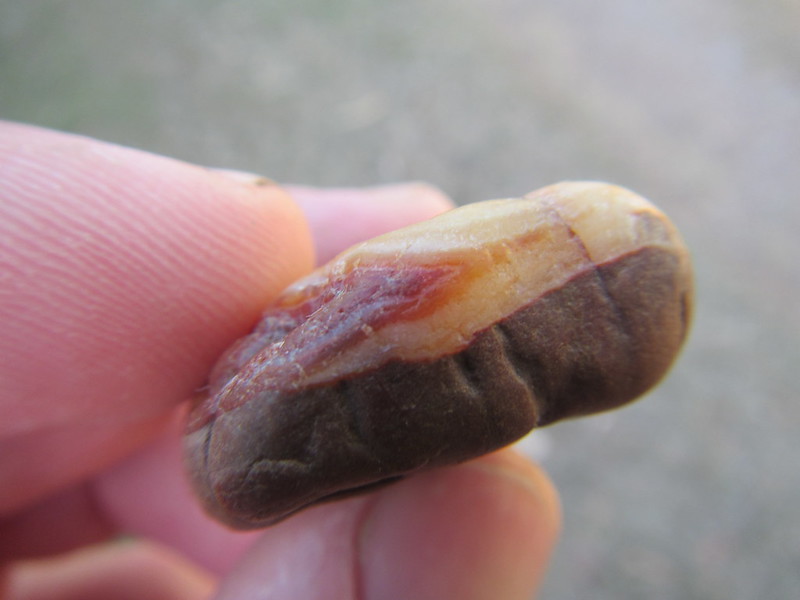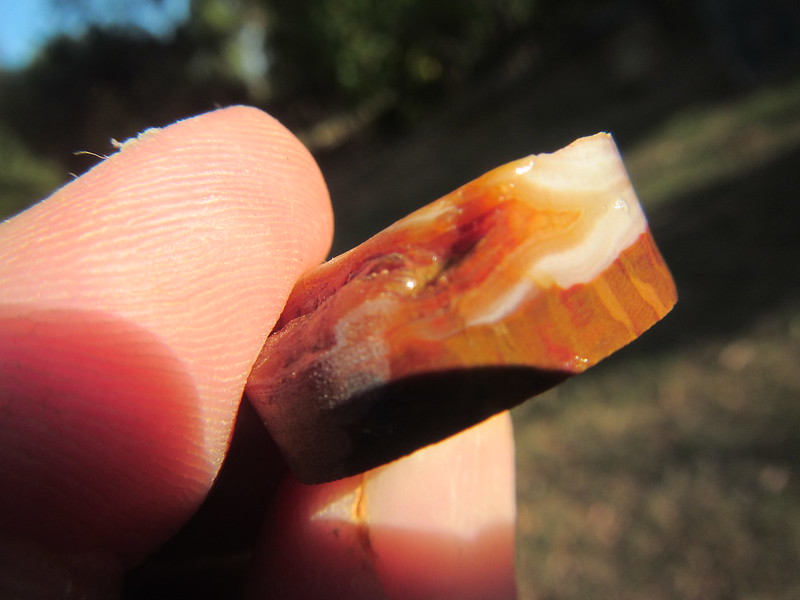Glad you enjoyed them LGH, hope to see some more of your finds soon.
-
Please join our new sister site dedicated to discussion of gold, silver, platinum, copper and palladium bar, coin, jewelry collecting/investing/storing/selling/buying. It would be greatly appreciated if you joined and help add a few new topics for new people to engage in.
Bullion.Forum

You are using an out of date browser. It may not display this or other websites correctly.
You should upgrade or use an alternative browser.
You should upgrade or use an alternative browser.
Chalcedonized petrifed wood from volcanic area
- Thread starter Lefty
- Start date

Help Support Prospecting Australia:
This site may earn a commission from merchant affiliate
links, including eBay, Amazon, and others.
In summary, I tend to think that the reason I assumed petrified wood to be usually of volcanic origin is because is that is likely to be the case for thousands of kms around where I live. Accordingly, I think volcanically-derived silicified wood likely makes up a not-insignificant portion of all the material in Australia, perhaps even a fifth or a quarter.
Does anyone have any thoughts on the matter?
I mentioned in an earlier post that precious opal in volcanic rocks was minor and rare in Australia, and I quoted some of the few localities where it has been recorded, mentioning one in New England (meaning the broader New England fold belt), Beechworth, Coolgardie etc. I've looked it up, and the New England area is the area around Springsure. So I won't argue the point - you seem to be looking in an area noted as one of the few areas in Australia where silica forming gems related to volcanics is known to be important. So we are talking at cross-purposes a bit.....
However I still doubt the fossil wood is related to volcanism (the precious opal in volcanic vesicles at Springsure may be). I mentioned 3 methods of formation and that direct relationship to silica related to volcanic activity was quite rare that a fairly common method of formation, that resulted in a SPATIAL relationship to volcanics, is that as the volcanics (which can be tuff) decompose, their silica is released into groundwater which then travels through gravels etc and replaces any wood present (long after the actual volcanic activity). This describes the process.
http://geology.com/stories/13/petrified-wood/
Petrified wood is common in Victoria and much appears to be more than 100 My older than any volcanics (eg in the Otway Ranges).
Does anyone have any thoughts on the matter?
I mentioned in an earlier post that precious opal in volcanic rocks was minor and rare in Australia, and I quoted some of the few localities where it has been recorded, mentioning one in New England (meaning the broader New England fold belt), Beechworth, Coolgardie etc. I've looked it up, and the New England area is the area around Springsure. So I won't argue the point - you seem to be looking in an area noted as one of the few areas in Australia where silica forming gems related to volcanics is known to be important. So we are talking at cross-purposes a bit.....
However I still doubt the fossil wood is related to volcanism (the precious opal in volcanic vesicles at Springsure may be). I mentioned 3 methods of formation and that direct relationship to silica related to volcanic activity was quite rare that a fairly common method of formation, that resulted in a SPATIAL relationship to volcanics, is that as the volcanics (which can be tuff) decompose, their silica is released into groundwater which then travels through gravels etc and replaces any wood present (long after the actual volcanic activity). This describes the process.
http://geology.com/stories/13/petrified-wood/
Petrified wood is common in Victoria and much appears to be more than 100 My older than any volcanics (eg in the Otway Ranges).
- Joined
- May 1, 2014
- Messages
- 1,958
- Reaction score
- 2,530
I've looked it up, and the New England area is the area around Springsure.
Do you mean that the New England belt of volcanics (I take it that's what you're referring to) runs all the way up here to central Queensland? The town of Springsure is in central QLD, about 65km south of Emerald, which is the administrative centre for the Central Highlands region. Emerald is a similar distance east of the Anakie sapphire field.
Stand on the high ridge along Kielambete road (which runs from Rubyvale township in the centre of the field out to the more isolated part of the gemfield called Reward) and you will see a similar vista to that around Springsure, volcanic plugs jutting up everywhere. But they must have been different somehow - the volcanics of the field produced sapphires, zircons and pleonaste whereas I've never found any of these things around Springsure. Likewise, the labradorite and opalized wood that are abundant at Springsure seem absent from the Anakie field. I did however once find a piece of an opalite-type material at the Glenalva section of the Anakie field, similar to bits I've found in the creek at Springsure. It was the only one though.
you seem to be looking in an area noted as one of the few areas in Australia where silica forming gems related to volcanics is known to be important.
Not sure if you mean more broadly than just chalcedonized pet wood but if you do then I'd say the key word here is known. I have reason to believe it's sometimes the case that the reason things are unknown in a region is blindingly simple - no one has ever really looked for them. The last time anybody did any significant amount of scratching the hills and gullies in this region was about 150 years ago. And those people were looking for one thing only - gold. They had almost no interest in coloured pebbles. Quite a bit of gold came from the Boyne valley near my home (Gladstone) in the 19th century but it seems only because a geologist happened to be present that sapphires, zircons and andradite garnets were recorded as well. Unfortunately, the exact locations are often lost in history. I know where the garnets are but they are on the property of a bloke known locally as "The Mad Yank" and he will supposedly shoot at you just for asking.
Once you realize what extinct volcanoes look like, you will be amazed at the sheer number of them in Central QLD and far beyond to the north and south. They are simply everywhere! And sometimes they are not obvious but they must have been there given what's lying around.
I was on the phone to father-in-law last week. He and MIL live in the Atherton tableand area. He told me he went down to the creek at the back of my wife's uncle and aunt's farm, noted the similar look of the ground and rocks to places we have been, went back and got his fine sieves. He proceeded to turn up a bunch of small, dark blood-red garnets (pyrope probably). None were gem quality.....but they were there and faceting grade ones probably are as well. Wife's uncle says he is happy for us to have a scratch in his creek but not to tell people specifically where it is - he doesn't want people crawling all over his property looking for rocks, which is fair enough. I think they probably exist all around the area.
Mind-blowing stuff - you never know what's in the ground
Cheers for that link, I will read that when I have time.
I've looked it up, and the New England area is the area around Springsure.
I will re-phrase that. When I referred to New England previously, I was referring to the geographic area of the New England Fold Belt (see diagram). The locality in the New England Fold Belt that I was referring to where precious opal occurs in volcanics was Opal Hill at Springsure. The volcanics are actually younger than the fold belt (they are younger than the folding of its rocks) but overlie the rocks of the fold belt, so occur in the same geographic area - what is called the New England Fold Belt or New England Orogen = number 4 on diagram
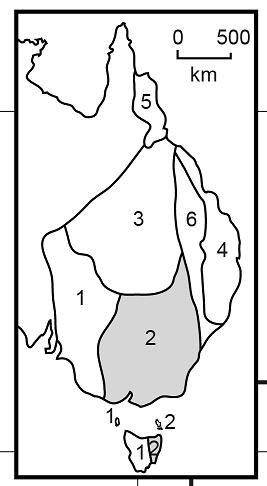
....a similar vista to that around Springsure, volcanic plugs jutting up everywhere. But they must have been different somehow - the volcanics of the field produced sapphires, zircons and pleonaste whereas I've never found any of these things around Springsure. Likewise, the labradorite and opalized wood that are abundant at Springsure seem absent from the Anakie field. I did however once find a piece of an opalite-type material at the Glenalva section of the Anakie field, similar to bits I've found in the creek at Springsure. It was the only one though.
Volcanics formed at much the same time tend to have different accessory minerals. The Tertiary volcanics of Victoria vary - those high in potassium around Woodend-Trentham havae zircons, rubies and sapphires in them. Some around Camperdown have only zircon in any quantity. The broad lava plains of SW Victoria which are low in potassium but higher in silica have none of these gems. All have a bit of common opal in gravels beneath them.
you seem to be looking in an area noted as one of the few areas in Australia where silica forming gems related to volcanics is known to be important.
Not sure if you mean more broadly than just chalcedonized pet wood but if you do then I'd say the key word here is known. I have reason to believe it's sometimes the case that the reason things are unknown in a region is blindingly simple - no one has ever really looked for them. The last time anybody did any significant amount of scratching the hills and gullies in this region was about 150 years ago. And those people were looking for one thing only - gold. They had almost no interest in coloured pebbles.
Probably so - Victoria had much bigger goldfields and often the gems were discarded as of no real value, but I have mates who have commercially mined the New England sapphires on a large scale, and they do a lot of systematic prospecting with budgets of millions per year ever since I worked up there in the early 1970s (not a lot of large-scale commercial interest in pet wood though - New England was producing 70% of the western world's gem sapphire at one time though). The point being that petrified wood is dead common and everywhere and not confined to volcanic areas but everywhere where there are no volcanics as well - I see it almost daily in the field in northern South Australia (just back from Coober Pedy-Painted Desert-Mt Dare-Birdsville-Tibooburra). As I said, three origins (i) silicified by silica in hot water coming directly from volcanoes (relatively rare - this was the 0.1% I was referring to). (ii) silicified in underlying gravels beneath lava flows long extinct, due to weathering dissolving silica from the overlying volcanics into cold groundwater that then flows through underlying gravels (a lot more common), (iii) silicified by silica in cold groundwater that derived its silica from rocks that are not volcanic (by far the most common). Over 45 years I have looked at silicified wood in the field from throughout Australia, to the Karoo of South Africa (where I have seen logs 70 cm in diameter and 5 m or more long) to the Colorado Plateau of Colorado, Utah and Arizona. All three types exist, and I think the overall abundance (Australia-wide and world-wide) is as I said. I also work a lot studying volcanoes around the world, and the water associated with them - I'm off to Rotorua again in 8 weeks time. Visited every commercial opalfield in Australia (even places like Stuart Ck and Lambina and Broken Leg and Opalton and the Haystacks or is it Hayricks), the diamond fields of South Africa and Namibia, the tourmaline of Karabib and calderite orange garnet of Namibia, the Sandawana and other emerald fields of South Africa and Zimbabwe, the ruby fields of Burma etc etc. - and my mates work elsewhere like the Brazilizn volcanic-hosted opal, the tanzanite and tsavorite fields of Africa and the sapphire fileds of Sri Lanka. I worked on the Tsumeb mine and haver nice dioptase. I'm not claiming to be the world's greatest expert and I suspect that you are as good or better than me at finding them, but I am also not just making claims completely off the top of my head (but hope a bit of past experience might aid prospecting). Simply my observations. The volcanics at Opal Hill aren't basalt from memory, but are silica rich lavas like andesites or rhyolites.
More to the point, some nice pieces in those photos.
I will re-phrase that. When I referred to New England previously, I was referring to the geographic area of the New England Fold Belt (see diagram). The locality in the New England Fold Belt that I was referring to where precious opal occurs in volcanics was Opal Hill at Springsure. The volcanics are actually younger than the fold belt (they are younger than the folding of its rocks) but overlie the rocks of the fold belt, so occur in the same geographic area - what is called the New England Fold Belt or New England Orogen = number 4 on diagram

....a similar vista to that around Springsure, volcanic plugs jutting up everywhere. But they must have been different somehow - the volcanics of the field produced sapphires, zircons and pleonaste whereas I've never found any of these things around Springsure. Likewise, the labradorite and opalized wood that are abundant at Springsure seem absent from the Anakie field. I did however once find a piece of an opalite-type material at the Glenalva section of the Anakie field, similar to bits I've found in the creek at Springsure. It was the only one though.
Volcanics formed at much the same time tend to have different accessory minerals. The Tertiary volcanics of Victoria vary - those high in potassium around Woodend-Trentham havae zircons, rubies and sapphires in them. Some around Camperdown have only zircon in any quantity. The broad lava plains of SW Victoria which are low in potassium but higher in silica have none of these gems. All have a bit of common opal in gravels beneath them.
you seem to be looking in an area noted as one of the few areas in Australia where silica forming gems related to volcanics is known to be important.
Not sure if you mean more broadly than just chalcedonized pet wood but if you do then I'd say the key word here is known. I have reason to believe it's sometimes the case that the reason things are unknown in a region is blindingly simple - no one has ever really looked for them. The last time anybody did any significant amount of scratching the hills and gullies in this region was about 150 years ago. And those people were looking for one thing only - gold. They had almost no interest in coloured pebbles.
Probably so - Victoria had much bigger goldfields and often the gems were discarded as of no real value, but I have mates who have commercially mined the New England sapphires on a large scale, and they do a lot of systematic prospecting with budgets of millions per year ever since I worked up there in the early 1970s (not a lot of large-scale commercial interest in pet wood though - New England was producing 70% of the western world's gem sapphire at one time though). The point being that petrified wood is dead common and everywhere and not confined to volcanic areas but everywhere where there are no volcanics as well - I see it almost daily in the field in northern South Australia (just back from Coober Pedy-Painted Desert-Mt Dare-Birdsville-Tibooburra). As I said, three origins (i) silicified by silica in hot water coming directly from volcanoes (relatively rare - this was the 0.1% I was referring to). (ii) silicified in underlying gravels beneath lava flows long extinct, due to weathering dissolving silica from the overlying volcanics into cold groundwater that then flows through underlying gravels (a lot more common), (iii) silicified by silica in cold groundwater that derived its silica from rocks that are not volcanic (by far the most common). Over 45 years I have looked at silicified wood in the field from throughout Australia, to the Karoo of South Africa (where I have seen logs 70 cm in diameter and 5 m or more long) to the Colorado Plateau of Colorado, Utah and Arizona. All three types exist, and I think the overall abundance (Australia-wide and world-wide) is as I said. I also work a lot studying volcanoes around the world, and the water associated with them - I'm off to Rotorua again in 8 weeks time. Visited every commercial opalfield in Australia (even places like Stuart Ck and Lambina and Broken Leg and Opalton and the Haystacks or is it Hayricks), the diamond fields of South Africa and Namibia, the tourmaline of Karabib and calderite orange garnet of Namibia, the Sandawana and other emerald fields of South Africa and Zimbabwe, the ruby fields of Burma etc etc. - and my mates work elsewhere like the Brazilizn volcanic-hosted opal, the tanzanite and tsavorite fields of Africa and the sapphire fileds of Sri Lanka. I worked on the Tsumeb mine and haver nice dioptase. I'm not claiming to be the world's greatest expert and I suspect that you are as good or better than me at finding them, but I am also not just making claims completely off the top of my head (but hope a bit of past experience might aid prospecting). Simply my observations. The volcanics at Opal Hill aren't basalt from memory, but are silica rich lavas like andesites or rhyolites.
More to the point, some nice pieces in those photos.
- Joined
- May 1, 2014
- Messages
- 1,958
- Reaction score
- 2,530
Cheers Goldirocks.
So if pet wood is filled with chalcedony/agate then it should be a reasonable suspicion volcanics were involved in the process? As I said, I have a couple of bits from non-volcanic areas and they just don't look or even feel the same. Sounds like a bit of a silly thing to say but I don't think they even sound the same - the stuff from Riverslea makes a sound something like two glass marbles clacking together when you do that (better go and check that again). Problem is (not a problem per se) that the volcanically-derived area in the north-east covers so much ground that it's pretty much all I ever see, I do a lot of fossicking but haven't fossicked as far and wide as you . It's almost hard for me to imagine a landscape without volcanic plugs and granite mountain ranges somewhere in the distance.
I even found a small piece of agate at work in Gladstone, one side was the bubbly agate nodule look, the other was a bunch of small quartz crystals. I saw it when the crystals flashed in the sun as I drove over it with the tractor and the wheel pulled it up out of the ground. It seems to have been in the native soil, not brought in - I found a line of almost completely buried granite boulders running through the spot and up the hill side. Possibly related to the Mount Larcom volcanics which overlook Gladstone. Dunno.
The Anakie field makes the same claim but whichever is correct doesn't matter
All very interesting stuff and I'd like to keep picking your brains
Cheers
So if pet wood is filled with chalcedony/agate then it should be a reasonable suspicion volcanics were involved in the process? As I said, I have a couple of bits from non-volcanic areas and they just don't look or even feel the same. Sounds like a bit of a silly thing to say but I don't think they even sound the same - the stuff from Riverslea makes a sound something like two glass marbles clacking together when you do that (better go and check that again). Problem is (not a problem per se) that the volcanically-derived area in the north-east covers so much ground that it's pretty much all I ever see, I do a lot of fossicking but haven't fossicked as far and wide as you . It's almost hard for me to imagine a landscape without volcanic plugs and granite mountain ranges somewhere in the distance.
I even found a small piece of agate at work in Gladstone, one side was the bubbly agate nodule look, the other was a bunch of small quartz crystals. I saw it when the crystals flashed in the sun as I drove over it with the tractor and the wheel pulled it up out of the ground. It seems to have been in the native soil, not brought in - I found a line of almost completely buried granite boulders running through the spot and up the hill side. Possibly related to the Mount Larcom volcanics which overlook Gladstone. Dunno.
New England was producing 70% of the western world's gem sapphire at one time though
The Anakie field makes the same claim but whichever is correct doesn't matter
All very interesting stuff and I'd like to keep picking your brains
Cheers
So if pet wood is filled with chalcedony/agate then it should be a reasonable suspicion volcanics were involved in the process? No, any type of pet wood could have that. Chalcedony is really just fine-grained quartz (microquartz). that usually but not always forms at low temperatures.
The Anakie field makes the same claim but whichever is correct doesn't matter. There is that definition problem again with New England - as I use it (and geos) it includes Anakie - the whole region supplied the sapphires.
The Anakie field makes the same claim but whichever is correct doesn't matter. There is that definition problem again with New England - as I use it (and geos) it includes Anakie - the whole region supplied the sapphires.
- Joined
- May 1, 2014
- Messages
- 1,958
- Reaction score
- 2,530
Ok, this is getting confusing - as I read it, the case was thought to be usually the opposite, in that agate formation typically involves some heat in the ground over and above the norm. Again, maybe I've just not gone far and wide enough but I've never found agates anywhere I can recall that did not appear associated with thermal processes.
Depends what you call chalcedony as well. I understand that chalcedony is microcrystalline quartz but from Monto to Riverslea to Mount Hay to Marlborough to Agate creek I can't think of a single example where general consensus is that hot ground is not related to formation.
The reason I asked is that this is important information from a fossicking point of view because the processes the appear to be involved often also brought other interesting things to the surface. Often the extinct volcanics are visible straight up but sometimes they can be hidden and what's lying on the ground is the only clue at first. Unless they were poor old western Victorian volcanoes which sound sadly a little boring.
I went through some of the Riverslea stuff last night and it appears that some significant portion has veins and pockets of banded agate an chalcedony, just visible with close examination. The only reason I didn't realize this was that I have done very little lapidary work with it, simply because it is extremely hard material and I have never had a saw bigger than a 6-inch and much of it is in chunks never sawn up for that reason. Even the smaller bits take some time to saw through and work down.
The Riverslea wood is found where the river has cut through the vicinity of a volcanic field. It is always found in conjunction with banded agates, un-banded chalcedonies, jaspers, volcanic looking material etc. The chalcedony/agate growing over and inside the wood appears to be the same material often found alongside it in botryoidal forms, bubbly nodules and enhydros. In addition, all these materials cease to be present when you move upstream out of the field - including petrified wood, there appears to be none at all at upstream river crossings.
I'm having difficulty conceiving a high likelihood of this being merely a string of coincidences. On a balance of probability, I think the Riverslea wood formation is volcanically-derived.
Perhaps eastern QLD and north-eastern NSW really do form a special geological region where things are quite different to the rest of Australia. This should be considered important owing to the size of the area, probably bigger than some small European countries.
Depends what you call chalcedony as well. I understand that chalcedony is microcrystalline quartz but from Monto to Riverslea to Mount Hay to Marlborough to Agate creek I can't think of a single example where general consensus is that hot ground is not related to formation.
The reason I asked is that this is important information from a fossicking point of view because the processes the appear to be involved often also brought other interesting things to the surface. Often the extinct volcanics are visible straight up but sometimes they can be hidden and what's lying on the ground is the only clue at first. Unless they were poor old western Victorian volcanoes which sound sadly a little boring.
I went through some of the Riverslea stuff last night and it appears that some significant portion has veins and pockets of banded agate an chalcedony, just visible with close examination. The only reason I didn't realize this was that I have done very little lapidary work with it, simply because it is extremely hard material and I have never had a saw bigger than a 6-inch and much of it is in chunks never sawn up for that reason. Even the smaller bits take some time to saw through and work down.
The Riverslea wood is found where the river has cut through the vicinity of a volcanic field. It is always found in conjunction with banded agates, un-banded chalcedonies, jaspers, volcanic looking material etc. The chalcedony/agate growing over and inside the wood appears to be the same material often found alongside it in botryoidal forms, bubbly nodules and enhydros. In addition, all these materials cease to be present when you move upstream out of the field - including petrified wood, there appears to be none at all at upstream river crossings.
I'm having difficulty conceiving a high likelihood of this being merely a string of coincidences. On a balance of probability, I think the Riverslea wood formation is volcanically-derived.
Perhaps eastern QLD and north-eastern NSW really do form a special geological region where things are quite different to the rest of Australia. This should be considered important owing to the size of the area, probably bigger than some small European countries.
- Joined
- May 1, 2014
- Messages
- 1,958
- Reaction score
- 2,530
A successful day at Riverslea - I picked up at least 50 kg of material, most of which is petrified wood. 
The temperature was no higher than average for this time of year - slightly lower even - but standing on a gravel field that absorbs and then radiates the heat of blazing sun, the heat on the gravel banks was oppressive. Quite draining actually. And the flies were unbelievable! I put an anti-fly head net on but they make it difficult to see the rocks on the ground clearly - I think they need a clear plastic window at eye level. Had to smother my head in Bushman, they still buzzed around my head in a cloud of hundreds but at least they wouldn't land.
The water in the river looked very inviting - but no way was I going to be croc bait! Just had to suffer the heat.
Heaps of wood, very little of the chalcedony. I think other rockhounds in the region have the same idea as me and are hitting the gravel banks hard before they're gone and while the wood was always more abundant, the brightly coloured chalcedony stands out and is quickly picked up. I did find a few pieces though.
Hopefully, a not insignificant amount of the wood will turn out to have coloured chalcedony and swirls of banded agate inside. Found a few small pieces that I'd be tempted to call opalized wood but I think agetized would be more accurate, veins of white and blue opalescent material through it.
Will post some pics at a later date - 50kg is a lot of stuff to sort through!
The temperature was no higher than average for this time of year - slightly lower even - but standing on a gravel field that absorbs and then radiates the heat of blazing sun, the heat on the gravel banks was oppressive. Quite draining actually. And the flies were unbelievable! I put an anti-fly head net on but they make it difficult to see the rocks on the ground clearly - I think they need a clear plastic window at eye level. Had to smother my head in Bushman, they still buzzed around my head in a cloud of hundreds but at least they wouldn't land.
The water in the river looked very inviting - but no way was I going to be croc bait! Just had to suffer the heat.
Heaps of wood, very little of the chalcedony. I think other rockhounds in the region have the same idea as me and are hitting the gravel banks hard before they're gone and while the wood was always more abundant, the brightly coloured chalcedony stands out and is quickly picked up. I did find a few pieces though.
Hopefully, a not insignificant amount of the wood will turn out to have coloured chalcedony and swirls of banded agate inside. Found a few small pieces that I'd be tempted to call opalized wood but I think agetized would be more accurate, veins of white and blue opalescent material through it.
Will post some pics at a later date - 50kg is a lot of stuff to sort through!
Ooohh the finds sound promising Lefty, can't wait to see what you've collected!
Sounds like a productive day. Crocs or the heat, what a choice  Maybe the crocs are guarding the good stuff
Maybe the crocs are guarding the good stuff 
- Joined
- May 1, 2014
- Messages
- 1,958
- Reaction score
- 2,530
shivan said:Sounds like a productive day. Crocs or the heat, what a choiceMaybe the crocs are guarding the good stuff

Somewhere along the river is a crocodile's cave, filled with opalized logs and basketball-sized chunks of carnelian
- Joined
- May 1, 2014
- Messages
- 1,958
- Reaction score
- 2,530
The gravel banks..
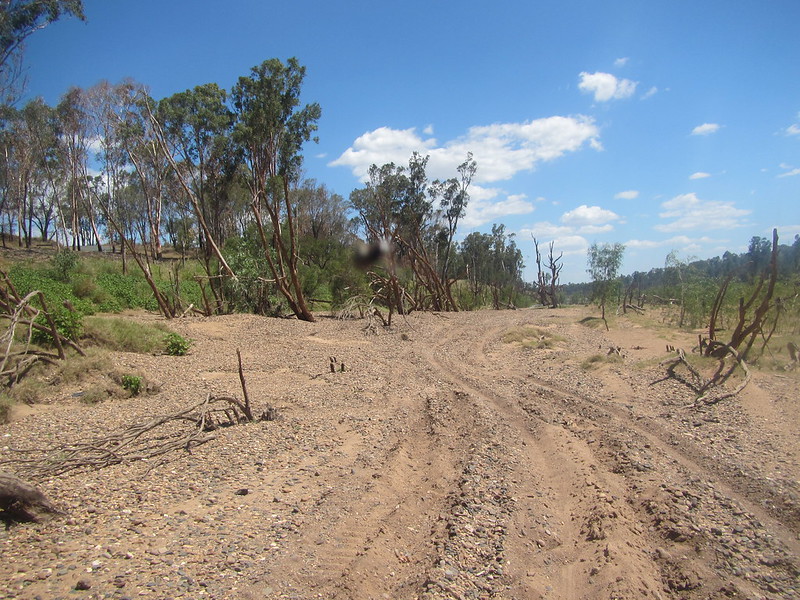
Some kind of conglomerate just below the gravel banks. It's black, shiny and looks like tar - but it's hard of course. A fair few smaller bits of it lying around.
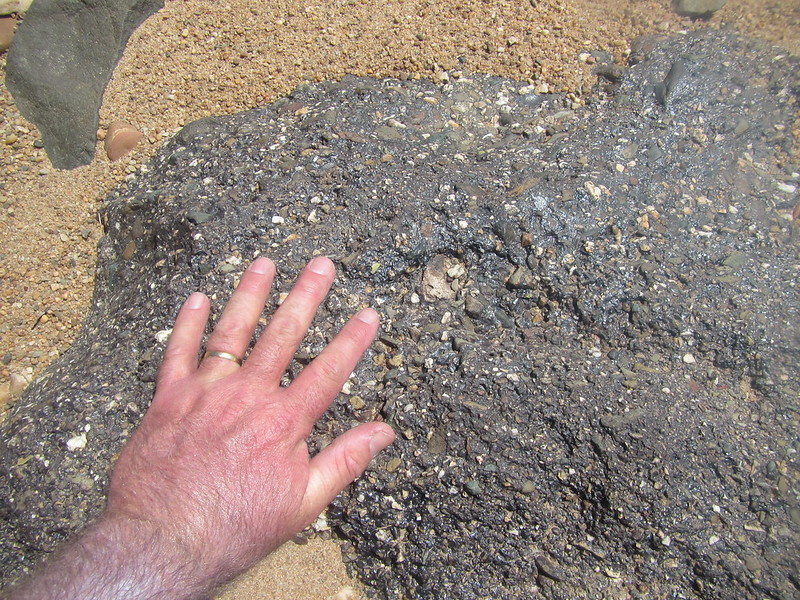
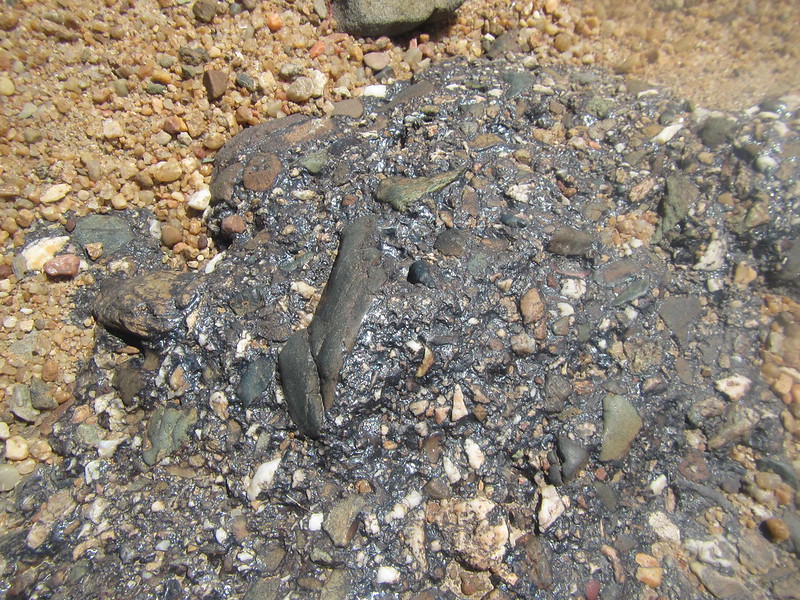
A piece of lava flow maybe? It's not a s obvious in the photo but to the eye it's made up of multiple layers like a layer cake and gives the impression of something that flowed in consecutive waves, picking up bits of other material. It's hard and makes a high-pitched clinking noise like glass when struck.
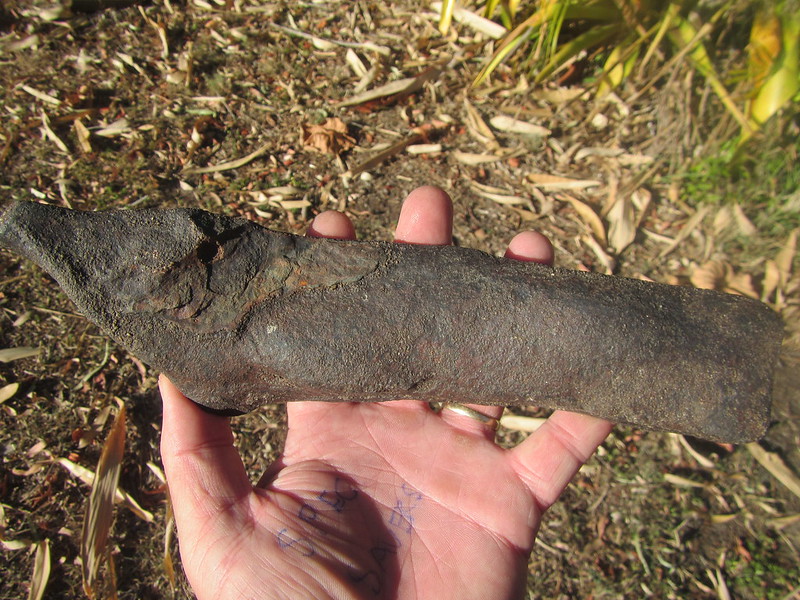
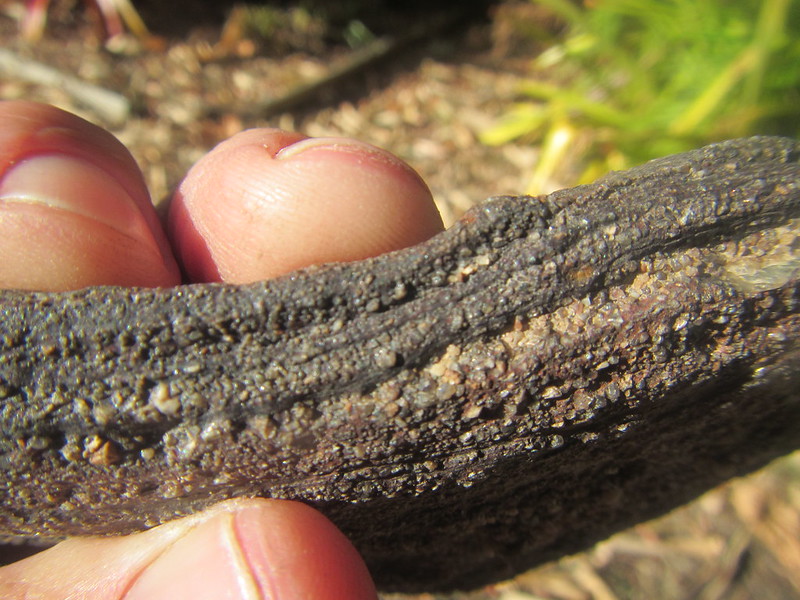
Might not look like it but there's 50kg there.
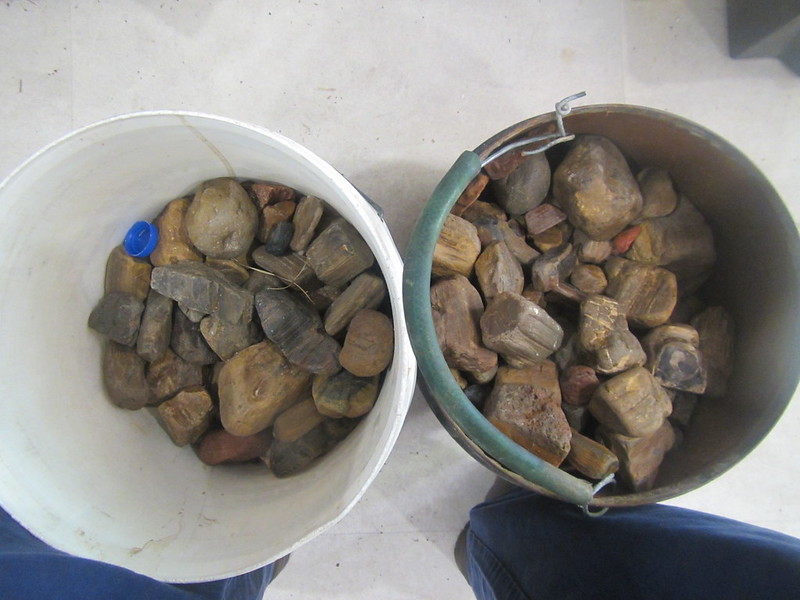
A small piece of log or large branch. Shame it's been tumbled down the river, probably had more surface detail before that.
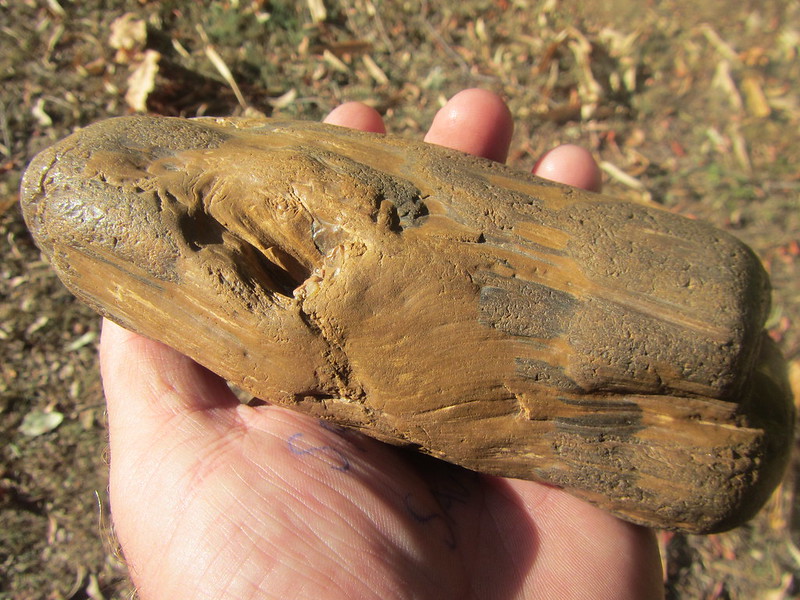
Fossilized hollow branch..
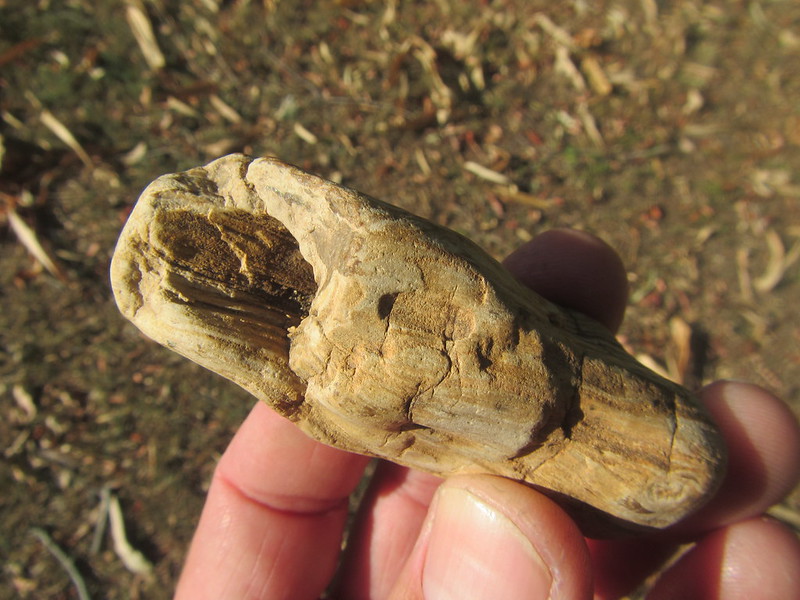
Agatized wood...
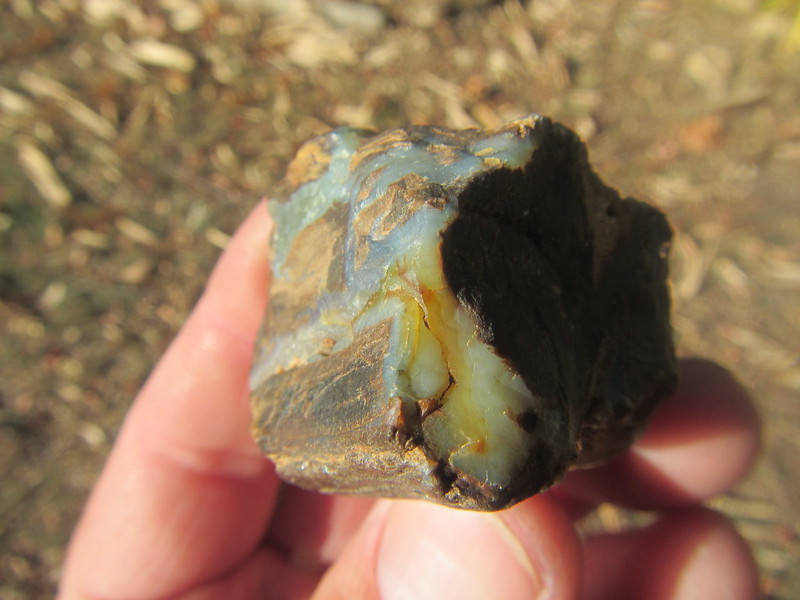
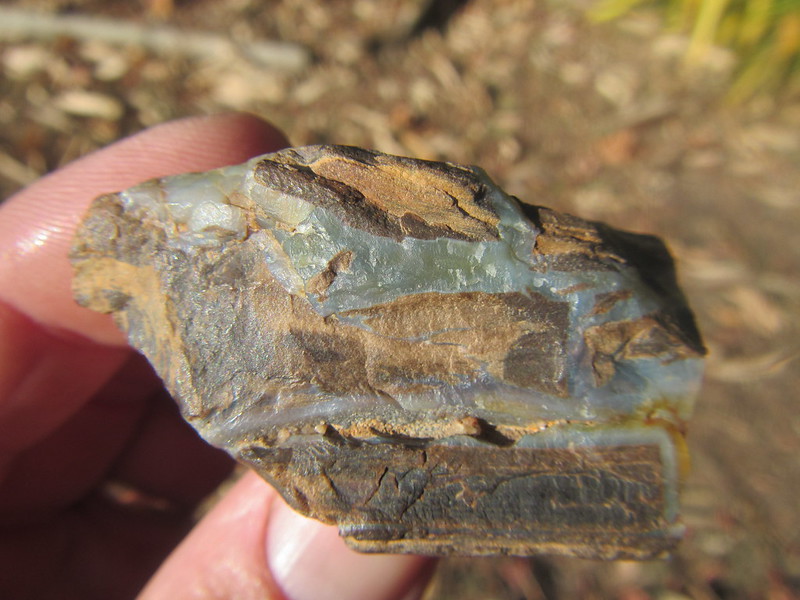
Chalcedony...
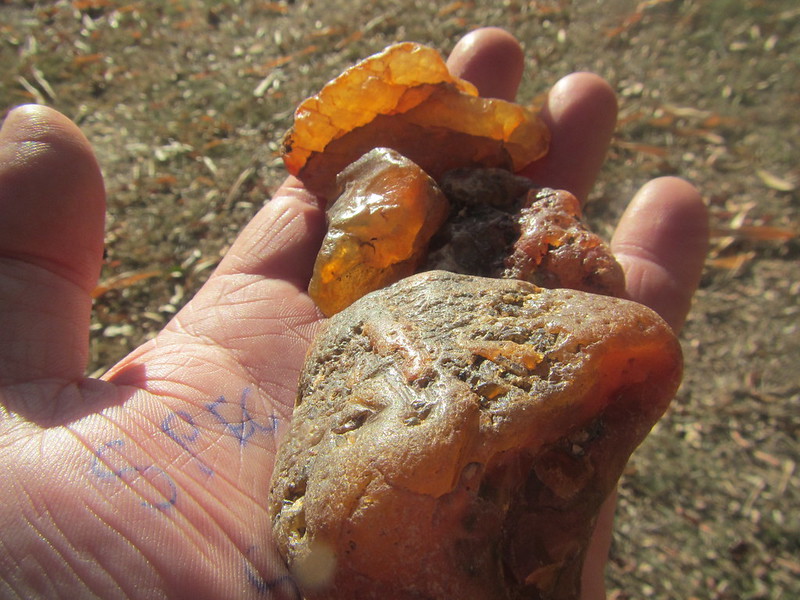
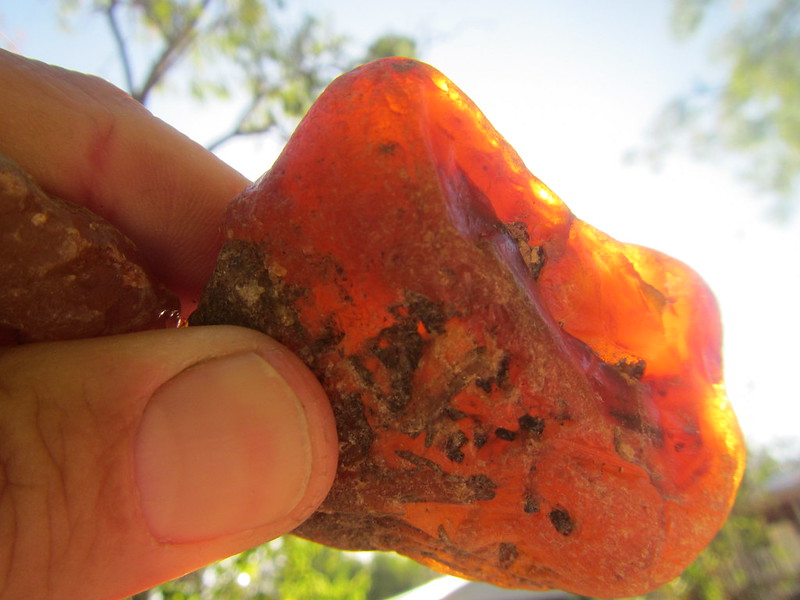

Some kind of conglomerate just below the gravel banks. It's black, shiny and looks like tar - but it's hard of course. A fair few smaller bits of it lying around.


A piece of lava flow maybe? It's not a s obvious in the photo but to the eye it's made up of multiple layers like a layer cake and gives the impression of something that flowed in consecutive waves, picking up bits of other material. It's hard and makes a high-pitched clinking noise like glass when struck.


Might not look like it but there's 50kg there.

A small piece of log or large branch. Shame it's been tumbled down the river, probably had more surface detail before that.

Fossilized hollow branch..

Agatized wood...


Chalcedony...


Some very cool rocks there mate! The conglomerate is cool, i think theres been a few different forces going on around the place there  I like the flows of your 5th photo which to me looks like something i got taught recently, an orthoquartzite, or gritstone, that do hole the history in their sequence, possibly tubidite? You managed to get some whopper colors there and really interesting bits ( and big! ), did you get to spec savers before, or after the fossick?
I like the flows of your 5th photo which to me looks like something i got taught recently, an orthoquartzite, or gritstone, that do hole the history in their sequence, possibly tubidite? You managed to get some whopper colors there and really interesting bits ( and big! ), did you get to spec savers before, or after the fossick? 
- Joined
- Jul 20, 2016
- Messages
- 115
- Reaction score
- 350
Good stuff you have there lefty I enjoy all the gems ? that you put on the site keep them coming rock god lol thanks again lgh??
Lefty, pic 2&3 could be a Lightning Strike? or is the area too large?
LoneWolf
LoneWolf
Some great pieces there Lefty. What an interesting spot.
Your first two photos of the conglomerate were interesting, it reminded me of a piece i have found in Kangaroo Valley.
Not sure if they would be similar or not, but the piece i found seems to be water worn stones and sand cemented in what seems to be obsidian. But i may be way off the mark.
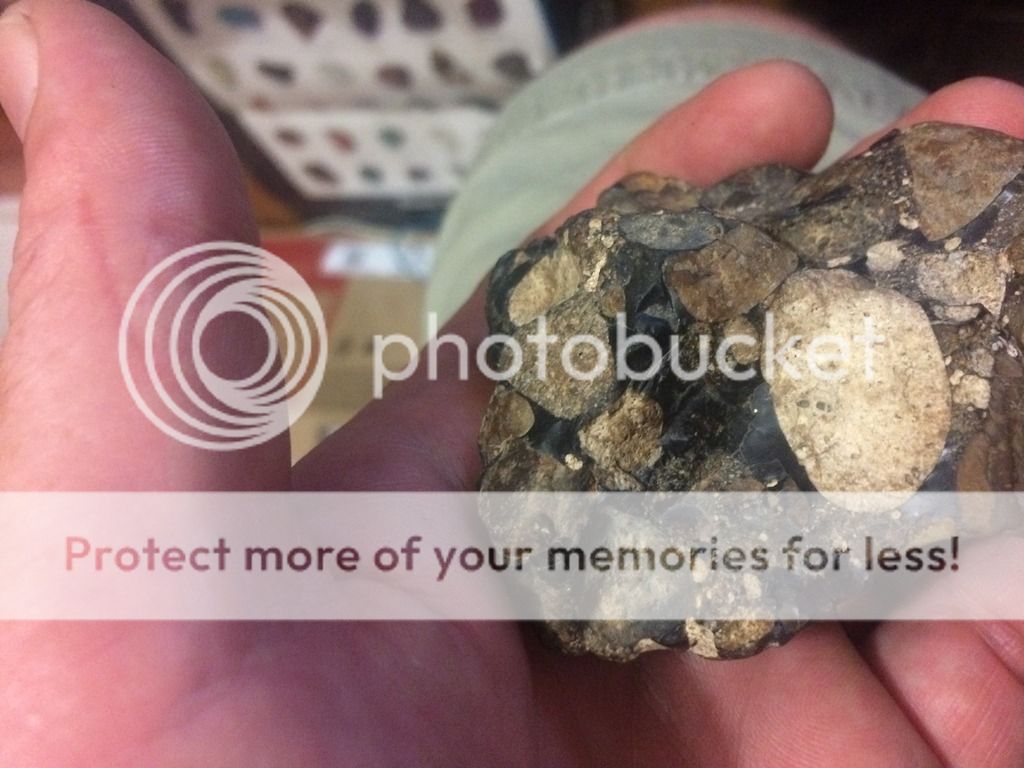
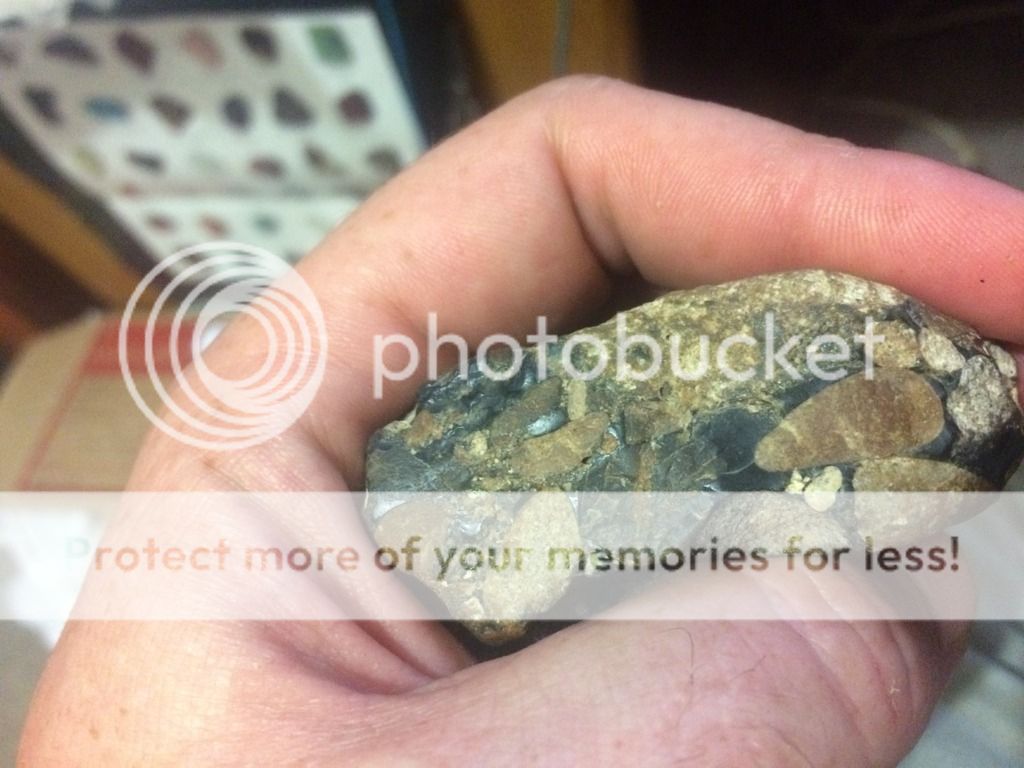
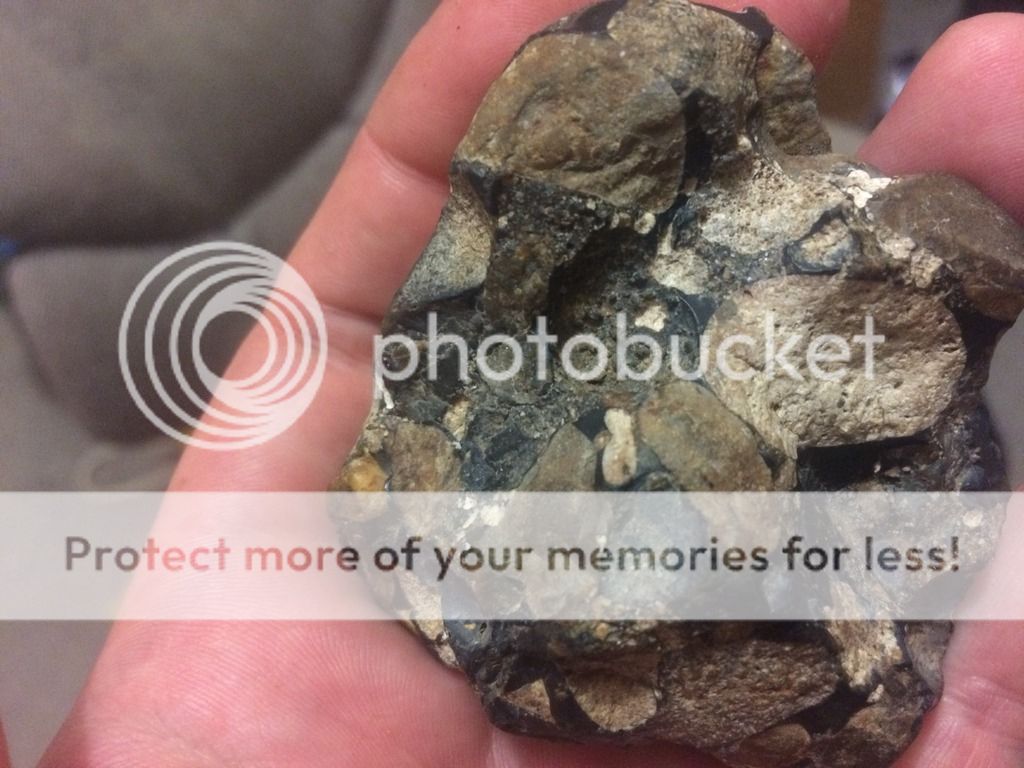
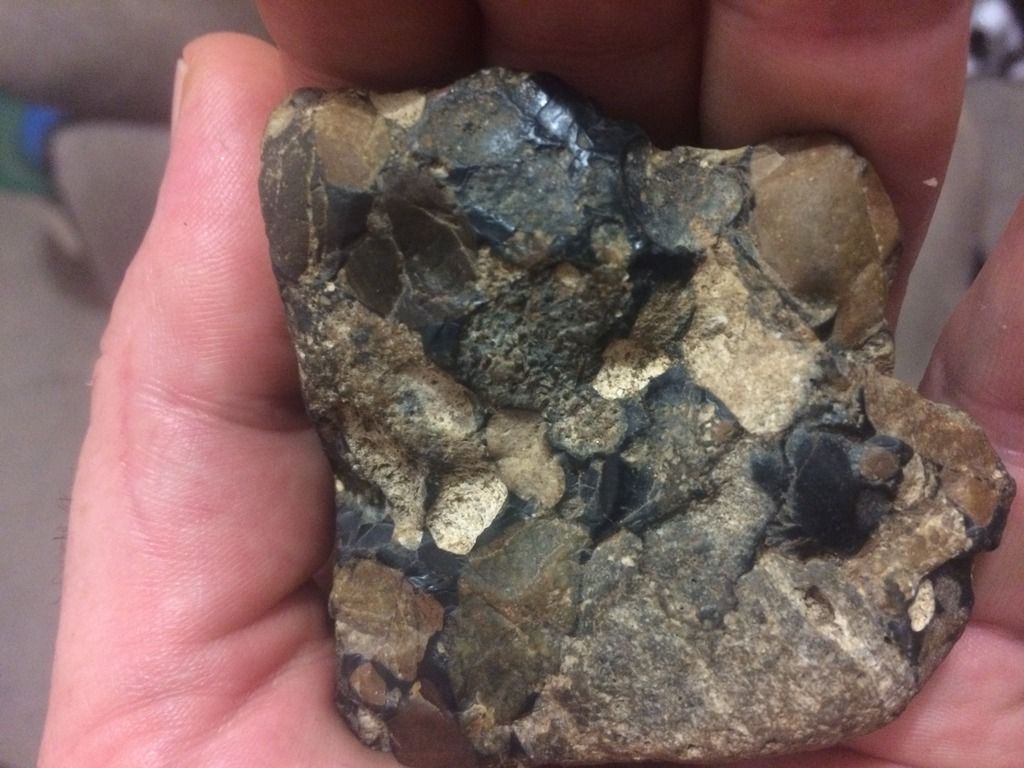
Your first two photos of the conglomerate were interesting, it reminded me of a piece i have found in Kangaroo Valley.
Not sure if they would be similar or not, but the piece i found seems to be water worn stones and sand cemented in what seems to be obsidian. But i may be way off the mark.




- Joined
- May 1, 2014
- Messages
- 1,958
- Reaction score
- 2,530
did you get to spec savers before, or after the fossick? wink
Just got there today AR :lol: Was picking up big rocks on Sunday, no need for specs then. But I've been putting it off too long, I've known for some time that my eyes aren't what they used to be. Had the eye test last week, just picked up my first ever pair of prescription glasses this arvo. BIG difference reading. I can still focus on small lettering without them but I have to squint to make it happen, they won't do it automatically anymore. Just finished a 2 carat green sapphire for a mate and wore the glasses while doing it, they definitely helped. No different when looking through the loupes but I don't use head loupes so having the glasses on made it easier.
Good stuff you have there lefty I enjoy all the gems ? that you put on the site keep them coming rock god lol thanks again lgh??
Cheers LGH, it was a nice big haul I go on Sunday. The area won't be there for much longer before they build a dam on the river and the gravel banks go under water so I'm making the most of the spot while I can.
Lefty, pic 2&3 could be a Lightning Strike? or is the area too large?
That's the biggest piece I've seen there Lone Wolf but there's smaller bits of the same stuff all over the place and some volcanic-looking bedrock in the secondary river bed (currently dry, main channel still flowing) have it over and around them as well - I think it might be volcanic.
Your first two photos of the conglomerate were interesting, it reminded me of a piece i have found in Kangaroo Valley.
Not sure if they would be similar or not, but the piece i found seems to be water worn stones and sand cemented in what seems to be obsidian. But i may be way off the mark.
I think you might be bang on the mark Shivan - there are lots of smaller bits with larger bits of gravel stuck together that look very, very similar to your photos. Waterworn gravel stones cemented together with what looks like some kind of obsidian. The books mention something in the area called "pitchstone", wonder if that's it? It sure looks like pitch or tar but is rock hard.
I think you may be right about it being pitchstone Lefty. This would explain the lack of conchoidal fracture and some of it looking waxy almost like chalcedony.
Very interesting.
Very interesting.
Similar threads
- Replies
- 8
- Views
- 8K
- Replies
- 5
- Views
- 3K
- Replies
- 1
- Views
- 3K



